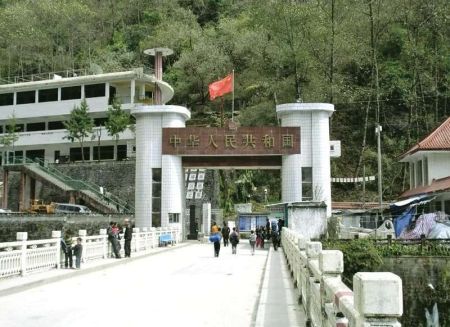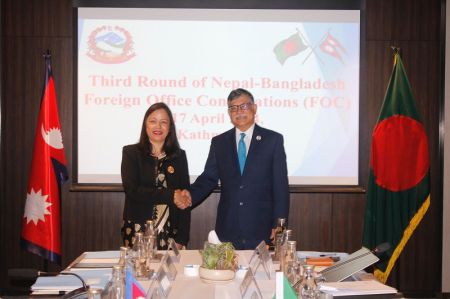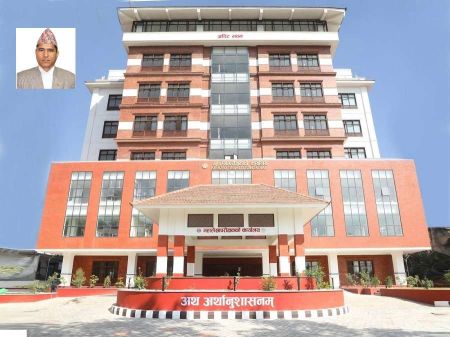.jpg) HaengLan Jo is the country representative of Korea International Cooperation Agency (KOICA) Nepal. And, Ujin Shim, is the Education Specialist at KOICA has recently organised a series of workshops on institute-industry partnership building in collaboration with the Federation of Nepalese Chambers of Commerce and Industry (FNCCI) and Council for Technical Education and Vocational Training (CTEVT). The main objective of the workshop is to develop a strong partnership between different Korean training institutes and industries in Nepal to produce marked based competent workforces and promote their employment opportunities mainly in Nepal. In an interview with Gaurav Aryal of the New Business Age, Jo and Shim shared ideas surrounding KOICA’s training and development programme as well as other projects. Excerpts:
HaengLan Jo is the country representative of Korea International Cooperation Agency (KOICA) Nepal. And, Ujin Shim, is the Education Specialist at KOICA has recently organised a series of workshops on institute-industry partnership building in collaboration with the Federation of Nepalese Chambers of Commerce and Industry (FNCCI) and Council for Technical Education and Vocational Training (CTEVT). The main objective of the workshop is to develop a strong partnership between different Korean training institutes and industries in Nepal to produce marked based competent workforces and promote their employment opportunities mainly in Nepal. In an interview with Gaurav Aryal of the New Business Age, Jo and Shim shared ideas surrounding KOICA’s training and development programme as well as other projects. Excerpts:What is the main idea behind KOICA’s programme on training and development of competent workforce in Nepal?
We initially started our intervention in the training and development of workshop through institution building approach. We are directing our effort towards reforming the government system and policies. For example, we established KNIT (Korea Nepal Institute of Technology) in 2012 and KU TTC (Kathmandu University Technical Training Center) in 2014. These institutions are already producing skilled training graduates. We are collaborating with CTEVT and Technical Instruction for Technical Instructors (TITI) to develop teaching manual for teachers, establishing e-library for students and teachers, among others. Such policy and system level interventions will not only be in Technical and Vocational Education and Training (TVET) but also in agriculture and health sectors too.
Our entire program including, the new workshop, aligns with Nepali government’s plan and policies. Our training and development programmes support government’s three-year development plan and contribute its long-term objective of sustainable economic growth and decreasing poverty.
How will the partnership between the Korean training institutes and industries of Nepal help in creating employment opportunities in Nepal?
The partnership between Korean training institutes and Nepali industries for workshop trainings is the first and a totally new type of intervention in Nepal. CTEVT as the apex government body for TVET education is responsible to train and manage workforce for development and other works through collaboration with industries and private sector organizations like FNCCI. But, they were not too effective.
The partnership aims to address the existing gap between training institutes and industries in Nepal. Technical schools and training centres run by both government and private sector are producing skilled graduates but nobody seems to bother about their job opportunities in the industries. On the other hand, industries are complaining the lack of skilled manpower. This is creating imbalance in the supply and demand side of the market. Our workshop is aimed at creating platform for discussion among the relevant people of industry and training institutes so that we can jointly come up with some institute-partnership model, which will be helpful for both sides.
Though we can’t create job opportunities directly, we can manage employment opportunities for our graduates through proper placement. For example KU TTC is collaborating with local industries in Kavre region to promote employment opportunities for its graduates. Similarly, KNIT also has already invited industries to observe it infrastructures and graduates’ skills so that they can trust and show their commitment for hiring the KNIT graduates. So, it’s about proper management of graduates in the existing industries rather than creating new one.
If trainees under this programme choose to go for foreign employment rather than working in Nepal, will it justify your programme objectives?
Youth going to foreign employment is a true and a very common scenario in Nepal. During the workshop of FNCCI, we heard that industries have problem finding skilled and trained workforce. Similarly, there is a problem of retention due to a high demand for skilled technicians. Industries in the Terai region lack trained workers so labourers from India are hired. If we produce graduates as per the demand of those industries, we can surely promote employment within the country.
Even those who return from foreign employment need to be placed in the existing industries, and this workshop will help on it. We can’t force our graduates to work within Nepal and get satisfied with low incomes, suffer poor working environment compared to that of foreign countries. However through the partnership with industries, we can find better job opportunities to our graduates. For example, Embassy of Korea is planning to establish collaboration with big employers like Hyundai Motors, and Samsung Electronics, to secure employment opportunities for our graduates.
KOICA has chosen to partner with CTEVT and FNCCI for its latest endeavours. What are its other projects that aim to work closely with the Nepali private sector?
We are currently developing projects in health, agriculture and education sector. For our agricultural project, we have formed the project implementing committee that includes local leaders, and participants from both government and private sector. The collaboration initiated by KOICA is the first of its kind in Nepal where the FNCCI has taken a lead to partner with government agency for creating job opportunities to trained graduates. Though it is in its starting phase, it has high growth potentials.
What are the challenges for a development partner like KOICA to work in Nepal? What are your suggestions to the government for improving the aid effectiveness?
a. Ownership: This is a crucial problem at local and central level. During the project planning and implementation, our majority effort goes towards enhancing maximum participation and partnerships with local community or beneficiaries and central level authorities so that they feel high level of ownership.
b. Budget expenditure: The untimely release of budget and the poor expenditure of the government is another problem, that creates huge barrier in our project implementation too.
c. Fragmentation: We feel like there is fragmentation of responsibility among ministries and agencies, which creates dilemma for us. For example TVET sector is managed by CTEVT under MoE but some of the issues like employment and training are managed by Ministry of Labour and Employment. In Korea, Ministry of Labour and employment handles the TVET sector so its relatively easy but still we aim to work together with all possible agencies to achieve our objectives.
d. Political instability: The Frequent change in government and the subsequent change in the leading government officers of ministries and other line agencies act as barrier to the smooth and successful execution of our projects and programs. It’s very challenging to implement the project and complete them on time, but we aim to boost the capacity of the Nepal government in terms of human resources and infrastructures.
e. Less access to information: Information on government systems and database are less accessible. Online availability would be very encouraging
f. Number of holidays: If government offices are closed, most of our works are also stuck.
The development of Korea’s economy is said to be possible because of the abundance of skilled human resources. Can we say that the Korean support for Nepal is based on the development model of South Korea and its past experiences?
South Korea is the only country, which has converted itself from being an aid recipient country to a donor country within five decades. Compared to Western donors, it gives us a competitive advantage to provide an effective and contextual development support to developing countries.
It is very interesting that Korea does not have abundant natural resources like Nepal but we have very skilled and educated human resources. Few decades ago, we also used to send our citizens to work abroad but we realized that the education and training of our human resources would be the best way to strengthen our economy. So, we focused highly on education. Through those lessons, we are trying to produce competent human resources in Nepal through modern and advanced technical training centres.
What are the future plans and KOICA’s upcoming projects for Nepal?
After establishing strong institutions for training and education like KUTTC and KNIT, we are providing assistance for system and policy level intervention. Our upcoming project ‘The capacity building of TVET teachers’ in partnership with TITI is our new project starting from 2015. Through this project we aim to achieve three objectives such as institutionalisation of training and development system in Nepal through teachers licensing system, enhancement of capacity building of teachers through exposure visit to Korea and dispatching Korean experts to Nepal and improvement of educational environment of TITI by establishing High tech information and communication building (ICT) at the TITI.





















